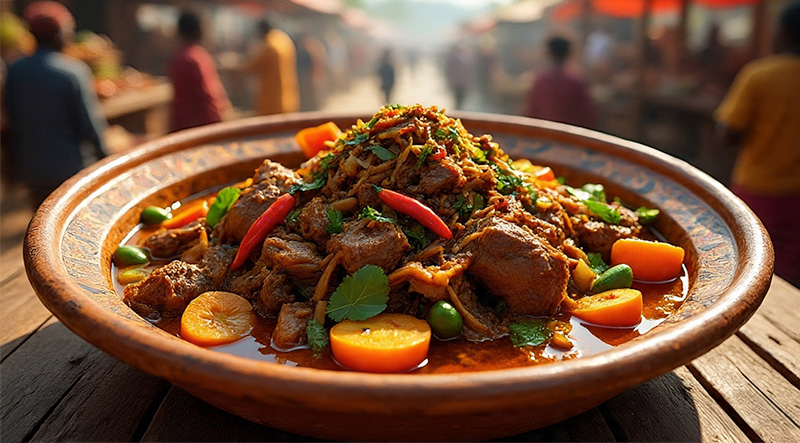The beloved national dish of Mali, Tiguadege Na, is rich, creamy, and full of strong West African flavor. It infuses each bite with comfort and tradition. Tender meat, usually beef or chicken, is simmered with tomatoes, onions, and regional spices to create a thick, velvety sauce that is incredibly satisfying in this irresistible peanut butter stew. Tiguadege Na, which is served with couscous or fluffy rice, is a celebration of Malian hospitality, warmth, and culinary tradition rather than merely a meal. Read More...
The History of Mali’s National Dish – Tiguadege Na:
In the heart of West Africa, where culinary traditions run deep and family meals are sacred, one dish stands out as a proud symbol of Malian identity: Tiguadege Na. Rich in flavor, heritage, and cultural meaning, Tiguadege Na—literally meaning “peanut butter sauce” in Bambara—is more than just Mali’s national dish. It’s a connection to the land, a reflection of its agricultural roots, and a warm bowl of home for millions.
Roots in Mali’s Agricultural Heart:
The origins of Tiguadege Na are closely tied to Mali’s agrarian history. For centuries, groundnuts (peanuts) have been a staple crop in the region, valued for their versatility, nutrition, and long shelf life. Peanuts were likely introduced to West Africa via Portuguese traders in the 16th century, and they quickly became a central ingredient in local cuisine.
Malians found creative and nourishing ways to incorporate peanuts into everyday meals, and peanut butter-based sauces became a fixture across the Sahel. The base of Tiguadege Na—made by simmering natural peanut paste with tomatoes, onions, and oil—provided a deeply flavorful, protein-rich sauce that paired well with staple grains like rice, millet, or fonio.
A Dish for All Occasions:
Though its ingredients are simple and widely available, Tiguadege Na holds a place of honor in Malian households. It’s a dish that’s equally at home in a modest village kitchen or on a celebration table during weddings and holidays.
Traditionally, the dish is made with beef, lamb, or chicken, slow-cooked in the peanut-tomato sauce until tender. Each family adds its own twist—some may include vegetables like carrots, okra, or sweet potatoes, while others may flavor the stew with local spice blends or bouillon cubes for extra depth.
Tiguadege Na is typically eaten communally, with family and friends gathered around a large dish, scooping up the stew with rice or pieces of to (a millet-based dough). The shared experience reinforces the strong cultural values of togetherness and hospitality in Malian society.
Peanut Sauce Across West Africa:
While Tiguadege Na is uniquely Malian in name and preparation, its concept resonates across West Africa. Similar peanut stews can be found in Senegal (maafe), Ghana (groundnut soup), and Nigeria (peanut stew), each with regional variations. What sets the Malian version apart is its earthy balance of richness and spice, and its deep roots in Bambara culinary traditions.
The dish has also found popularity outside of Mali, especially in West African diaspora communities, where it continues to be a beloved taste of home.
Modern Appeal and Cultural Legacy:
In modern Mali, Tiguadege Na remains a culinary mainstay. It is taught in homes from a young age, passed down through generations as a foundational recipe. Its simplicity, nutritional value, and rich flavor have helped it withstand the test of time, even as globalized eating habits influence urban centers.
Restaurants in Bamako and beyond proudly serve Tiguadege Na to locals and tourists alike, often as part of cultural experiences that showcase traditional cooking. The dish has also earned attention in international cookbooks and food blogs, celebrated for its hearty texture, plant-based protein, and comforting taste.
A Bowl of Culture:
At its core, Tiguadege Na is a dish of resourcefulness, flavor, and pride. It speaks to Mali’s agricultural heritage, its communal values, and its ability to turn humble ingredients into something memorable and nourishing. Whether served in a clay pot in a rural village or on a porcelain plate in a capital city restaurant, Tiguadege Na remains a true emblem of Malian identity and West African culinary excellence.
Brown the Meat:

Sauté the Aromatics:
Add the Peanut Butter:

Simmer the Stew:
Adjust and Serve:

Tips & Notes:
Tiguadege Na is the ultimate Malian comfort food—rich, hearty, and deeply satisfying. Serve it at gatherings or as a weeknight dinner, and enjoy a taste of Mali’s culinary soul.
The total preparation and cooking time for Tiguadege Na is approximately 1 hour and 15 minutes. This includes about 15–20 minutes of preparation, such as chopping vegetables, browning the meat, and mixing the sauce, followed by 50–60 minutes of cooking time to allow the stew to simmer and develop its rich, creamy texture. If you're serving it with rice or millet, you can prepare that simultaneously, making this a hearty and satisfying meal ready in just over an hour.
A single serving of Tiguadege Na, based on the provided recipe (serving 4–6), contains approximately 450–550 calories. This estimate includes around 200–250 calories from the meat (chicken or beef), about 150–200 calories from the peanut butter, and the remaining calories from the oil, onions, tomatoes, and optional vegetables like sweet potatoes or carrots. If served with a cup of white rice or millet (adding an additional 200 calories), the total can rise to 650–750 calories per serving. The dish is nutrient-dense and filling, offering a balance of protein, healthy fats, and fiber.







